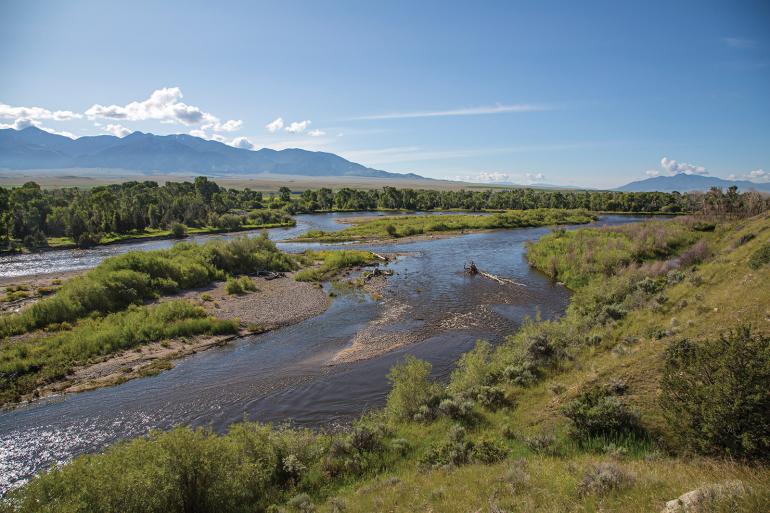Between the Lines
Reading the water to find fish.
In the world of fly fishing, you may hear that 10% of anglers catch 90% of the fish. I used to believe that the 10% were just better anglers, until one day on the lower Madison years ago. As I watched a flotilla of boats make their way downriver, I noticed a few guides, with anglers that might not qualify as “experienced,” catching the majority of the fish. Why? It all boiled down to the ability of the rower to read the water.
Reading water is an essential skill for catching fish. Near Bozeman, it can be overwhelming with the incredible diversity of river flows and morphologies. From high mountain creeks to massive tailwaters, there’s a lot to know. Here, I’ll break it down into four simple variables that affect fish behavior and holding locations: food, oxygen, shelter, and people.
Food
Fish that live in cold western streams epitomize the importance of “calories in” versus “calories out.” When reading water, a trout’s appetite is the most important consideration. Fish look for areas that require low exertion to hold in, but still have easy access to food. The majority of aquatic nourishment is rolling through the current, so think about the soft edges of riffles, seam lines behind islands and rocks, or foam lines. Foam is a great indicator of food, as it congregates where the current pushes it—much like bugs do. Less obvious areas are drop-offs, riffle tail-outs, and banks. Drop-offs provide a current break for easy holding, with plenty of food coming over the top. Tailouts, meanwhile, are excellent when food is plentiful. Typically, less food makes it to the bottom of riffles, but because tailouts create a large holding area, fish can cruise and have access to additional feeding lanes. When water temperatures plummet and food becomes a lot less abundant, fish seek deep, slow areas where they can hold with little effort while still having access to some food. On cold days, tail-outs can be the ticket.
Fish are smart in highly-pressured rivers, and people are the biggest predator out there—especially for larger fish.
Oxygen
Oxygen is the next major consideration when looking for holding water. Oxygen especially comes into play as water temperatures increase, because the dissolved oxygen content decreases. This pushes fish into faster-moving water such as riffles. Although riffles require high caloric exertion to hold in, they have plentiful food, making them a viable option. Riffles also fold oxygen into the water, allowing fish to survive warmer months. When fishing riffles, keep in mind that it only takes a softball-sized rock to hold an 18-inch fish in its eddy. Rocky riffles also provide plenty of soft water, oxygen, and food to keep fish happy and healthy. This type of water is best when river temperatures climb into the mid-60s or higher. Once the temperature hits 70, it’s best to leave the fish alone. Survival rates are incredibly low at anything over 70 degrees.
Shelter
The third variable is shelter. There are a lot of predators out there: birds, other fish, and anglers—all of which force fish to seek shelter. The old adages like “wood is good” and “rocks rock” are great places to start. Wood provides excellent overhead protection and easy cover from predatory fish. Rocks offer broken water and shade, making it difficult for overhead predators to see fish. Deep water also makes for good cover, as fish can disappear to the bottom. When the sun is high, and visibility is good, targeting sheltered areas can be a game-changer.
People
Finally, we dive into the human aspect of fishing. Fish are smart in highly-pressured rivers, and people are the biggest predator out there—especially for larger fish. When fishing a heavily-hit river, seek out areas that fellow anglers may have overlooked. When food is abundant and water temperatures are reasonable, a few casts to non-descript, “random” water can change the day for the better.
This summer, focus on recognizing holding patterns based on conditions, and you might be surprised just how well the patterns translate among different rivers across southwest Montana and beyond.
Jake Walbridge is the manager at Montana Troutfitters.










